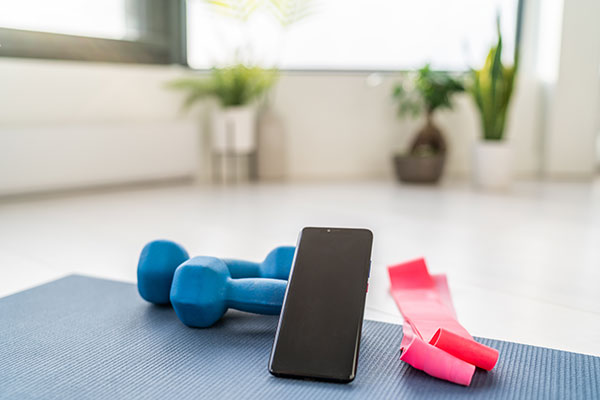Why it’s critical to exercise now, more than ever
COVID-19 is keeping everyone isolated in their homes, but the increased vulnerability of older adults to the coronavirus serves to intensify the adversity that everyone is facing at this time. We are all experiencing new health concerns for ourselves and our families with fewer outlets to alleviate the resulting stress and anxiety. We are now isolated in our homes, unable to visit with friends and family. Concerns about having access to food and other basic needs run rampant. Yet we cannot go to our favorite exercise class where we release stress and find joy through catching up with our classmates.
These frustrations and sources of anxiety are heightened for older adults who are advised to adopt even more stringent measures of physical separation to stay safe.
But there is good news – older adults can stay active and fit at home and doing so may be more important now than ever.
Sedentary behavior can worsen health
Not only does sitting too much lead to energy imbalance and weight gain, it deteriorates health in other important ways. This is clearly a risk as people’s regular routines are disrupted, they can’t get out and about, and they have fewer options for exercise. In an unfortunate contradiction — people’s health may suffer because they are trying to prevent the spread of coronavirus if they don’t find ways to maintain their physical activity. For example, inactivity leads to loss of muscle strength and endurance, which can impact balance and activities of daily living. Other concerns for older adults are the loss of bone mass that can lead to increased risk of fractures and reduced circulation.
Over the long term, sedentary behavior contributes to a myriad of chronic diseases including diabetes, cardiovascular disease and cancer, and also reduces life expectancy. A lesser known consequence of inactivity is an increase in inflammation in the body, which is a primary link between inactivity and disease. Of particular interest right now, increased TV watching itself is a significant risk factor for cardiovascular disease.
Staying physically active during this time can help older adults maintain a good outlook and bolster their immune system, which are particularly pertinent now. Especially among this demographic group that is primarily sedentary under normal circumstances.
Exercise improves outlook and alleviates stress and anxiety
Social isolation, stress and anxiety have skyrocketed among older adults since COVID-19 began its rapid spread. We surveyed older adults and found that the number who often feel isolated or lack companionship has increased threefold since before the coronavirus situation. Similarly, three to four times as many seniors are experiencing stress and anxiety daily. Primary contributors to the increase in stress and anxiety include not knowing when things will return to normal, concerns about the health of friends and family, and limited social interaction according to the 3,500 respondents to our national survey.
It is well established that regular physical activity improves mental health and reduces depression. Research has shown this benefit for SilverSneakers® participants. Regular participation in the program cuts depression risk in half and reduces mentally unhealthy days by 30-40%. Researchers have also found that exercise lifts mood and reduces stress and anxiety. These effects are not only the result of the endorphins released at the time of exercise, but a number of neurological and biochemical pathways.
Physical activity may help protect against COVID-19
A new study from a researcher at the University of Virginia finds that exercise can prevent or reduce the severity of acute respiratory distress syndrome (ARDS), a major cause of death in patients with COVID-19. Even a single session of exercise increases production of an antioxidant that protects against ARDS as well as several chronic diseases, from heart failure to osteoarthritis.
Exercise also plays a key role in strengthening the immune system. There is a rapid boost in immune response each time we exercise that enhances our ability to fight off infection in the hours after an exercise session. For older adults in particular, who are often more susceptible to getting sick, the research shows that reduced physical activity is a primary cause of reduced immunity as we age that contributes to higher risk of infection, and non-communicable diseases including cancer and chronic inflammatory disorders. In other words, older adults are more susceptible to viral infections, such as COVID-19, not just because they are older, but because they sit more.
Conversely, evidence shows that a physically active lifestyle can reduce age-related declines in immune function and diminishes the risk of contracting a range of communicable diseases including viral and bacterial infections.
New options for staying active
With fitness locations, senior centers, and other popular venues for group and independent exercise closed due to COVID-19, there are fewer options for people to stay physically active. However, our national surveys of SilverSneakers members show that people are still finding ways to keep moving. Many are spending more time outside, walking or catching up on household chores.
Out of necessity, older adults are becoming more comfortable with video conference applications and live streaming that allow them to join exercise classes in real time and use of live video applications for exercise classes has grown exponentially. In our last survey, three-quarters of those surveyed said they have used live-video applications and, of that group, 83% have taken live video exercise classes since the onset of COVID-19, compared to 31% before the current crisis. The need to stay connected has driven adoption of live video technology and two-thirds of those we surveyed said they are more comfortable with these applications now than they were before COVID.
While the change in how people exercise may have started because of COVID, it may change how people exercise moving into the future. One-third of people who we asked said that they will continue to take virtual exercise classes after it becomes safe to go to the gym. But most of this group would prefer only some of their exercise to be virtual and wish to return to in-person classes, too.
To help our members during the current time, we are providing multiple options to stay engaged. The increased demand for at-home exercise classes has been evident by the increased views of the on-demand library. We are also helping to meet the need beyond just our members with classes offered two to three times a week on Facebook Live, with more than 1.43 million views so far. Additionally, we have quickly ramped up the use of Zoom technology for live classes specifically for SilverSneakers members. The feedback from the SilverSneakers Live classes has been overwhelmingly positive and nearly all virtual class attendees say they plan to attend the live classes multiple times a week going forward.
At Tivity Health we have been intensely focused on finding ways to keep our SilverSneakers members engaged in fitness while staying safe at home. To learn more about opportunities to help your senior population stay active, contact us today.















